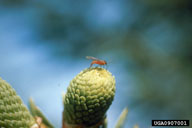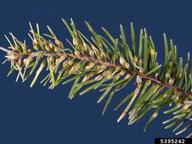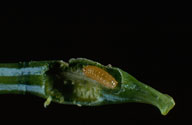Balsam gill midge
Paradiplosis tumifex Gagné (Diptera: Cecidomyiidae)
Orientation to pest
Balsam gall midge, Paradiplosis tumifex Gagné, is a native North American cecidomyiid fly that galls needles of balsam (Abies balsamea [L.] Miller) and Fraser fir (Abies fraseri [Pursh] Poir.). In older literature, these galls were mistakenly attributed to another species, Dasineura balsamicola (Lintner), which is an inquiline that invades the galls of P. tumifex, killing it and feeding on the gall tissue. Paradiplosis tumifex has a wide distribution, being found throughout the ranges of its two main hosts. The gall midge overwinters as a larva in the soil under an infested host tree. Pupation takes place in spring, and adult emergence occurs shortly thereafter. Eggs are laid in developing needles, and larval feeding causes quick development of gall tissue in immature needles. In late fall, larvae leave the galls and drop to the ground for the winter. There is one generation per year. Galling is of concern only in Christmas tree plantations, not forests.
Hosts commonly attacked
This gall midge attacks needles of balsam fir (A. balsamea) and Fraser fir (A. fraseri).
Distribution
This species is found throughout the ranges of balsam and Fraser firs, being much of southeastern Canada and adjacent areas of the northeastern United States (range of balsam fir), plus the sky islands of the southern Appalachian Mts. (range of Fraser fir).
Images of balsam gill midge
| Figure 1. Adult balsam gall midge, Paradiplosis tumifex | Figure 2. Balsam gall midge galls on balsam fir | Figure 3. Larvae of the balsam gall midge exposed by opening the gall |
Important biological control agents related to this pest species
Parasitoids of this gall maker include the encyrtids Pseudoencyrtus borealis MacGown, Tetrastichus cecidivorus MacGowan, Tetrastichus marcovitchi (Crawford,), Tetrastichus whitmani (Firault), and the platygasterids Platygaster abicollis MacGown and Osgood and Playtgaster mainensis MacGown and Osgood.
Web links for information on balsam gill midge
- Fact Sheet | Natural Resources Canada
- Powerpoint Presentation by Ronald S. Kelley | Vermont Department of Forests, Parks and Recreation
Highly detailed biology and control information - Fact Sheet from Maine Forest Service | State of Maine Department of Conservation
Articles
- Osgood, E. A. and R. J. Gagné. 1978. Biology and taxonomy of two gall midges (Diptera : Cecidomyiidae) found in galls on balsam fir needles with description of a new species of Paradiplosis. Annals of the Entomological Society of America 71: 85-91.
- West, R. J. and J. D. Shorthouse. 1982. Morphology of the balsam fir needle gall induced by the midge Paradiplosis tumifex (Diptera: Cecidomyiidae). Canadian Journal of Botany 60: 131-140.
- Räther, M. and N. J. Mills. 1989. Possibilities for the biological control of the Christmas tree pests, the balsam gall midge, Paradiplosis tumifex Gagné (Diptera: Cecidomyiidae) and the balsam twig aphid, Mindarus abietinus Koch (Homoptera: Mindaridae), using exotic enemies from Europe. Biocontrol News and Information; 10 (2): 119-129.
- Osgood, E. A., R. L. Bradbury, and F. A. Drummond. 1992. The balsam gall midge - an economic pest of balsam fir Christmas trees. Maine Agricultural Experiment Station Technical Bulletin No. 151, 30pp. viewable at http://library.umaine.edu/maineaes/technicalbulletin/tb151.pdf






